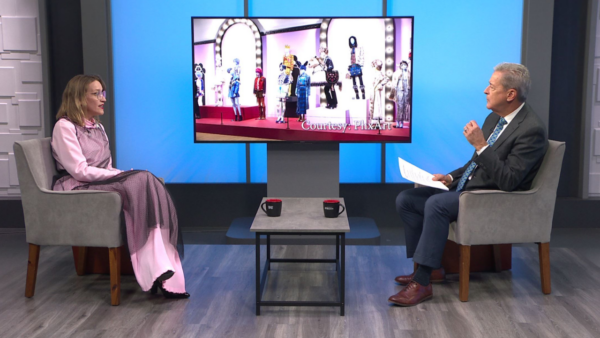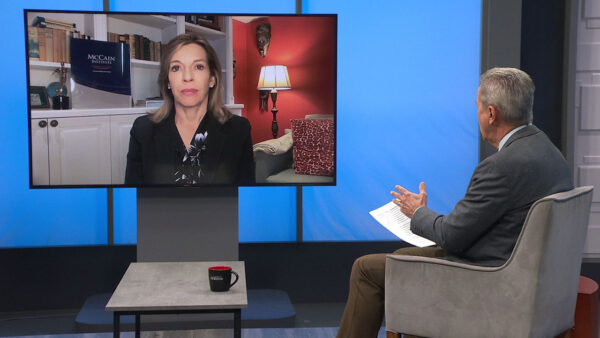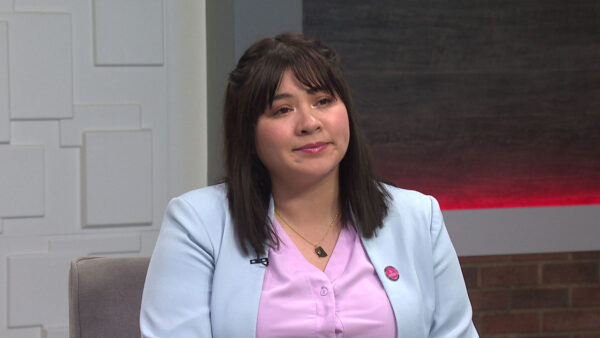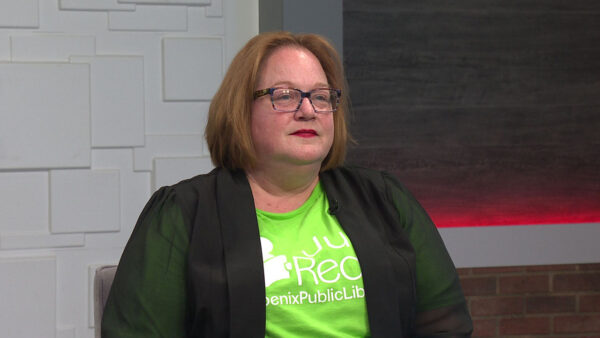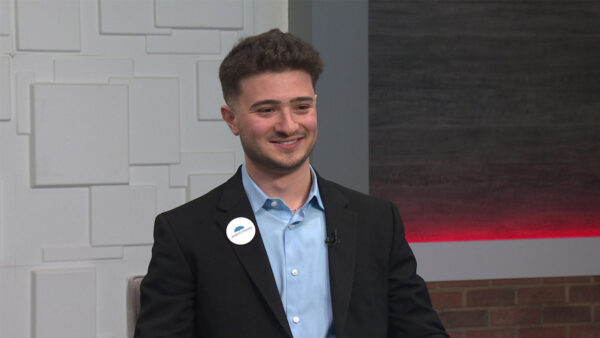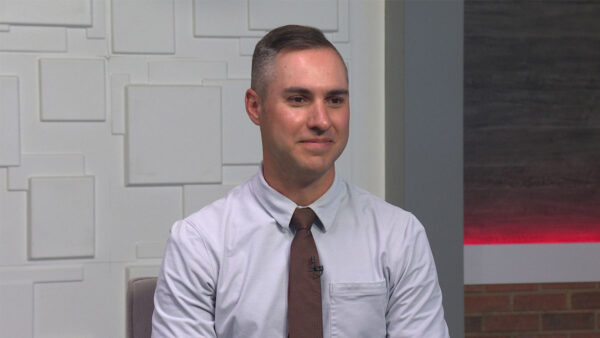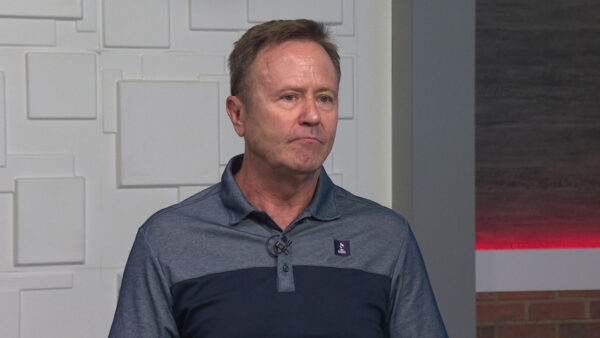The Arizona Corporation Commission recently approved one of the most aggressive energy efficiency standards in the nation. It requires regulated utilities to reduce the amount of energy they sell 22% by 2020. Jeff Schlegel of the Southwest Energy Efficiency Project and ASU professor Matthew Croucher discuss what it will take to reach that goal.
Ted Simons: The Arizona Corporation Commission approved one of the most aggressive efficiency standards in the nation. It required electric facilities to sell less energy. The utilities are going to need your help. David Majure reports.
David Majure: In a growing state like Arizona, meeting the ever-increasing demand for electricity is expensive. It requires building new power plants, which leads to boosting your bill. One way to fight rising rates is by saving energy. A great example of something everyone can do in their homes -- Sometimes it's as easy as replacing a light bulb.
Tom Hines: They are available for less than a dollar. It's a 60-watt light bulb. I'm going to turn it on and it's drawing about 60 Watts. So we have three CFLs or compact fluorescent lights here. I'm going to turn this meter on and show you these three bulbs are actually only drawing about 50 Watts of power. We are using less energy to produce three times the amount of light.
David Majure: They also produce less heat which helps out your air conditioner.
Tom Hines: It's all about taking a message to customers, informing them of ways to save on their bills and homes and in their businesses.
David Majure: APS has been helping customers save energy for years. Soon it will be required to do so. In July the Arizona Corporation Commission unanimously approved a new energy efficiency standard.
Kris Mayes: This energy efficiency standard that we've established a few weeks ago will make Arizona, if not the leader nationally in energy efficiency, then definitely one of the leaders.
David Majure: It reduces the energy sold to 22% by the year 2020.
Kris Mayes: I said I think it's probably the most important thing I'll ever do in my life. It'll save rate-payers $9 billion that they aren't going have to spend to build big power plants.
Jim Wontor: APS is in support of standards for a couple of reasons. First, it's good for our customers. It helps our customers manage their electric bill each month. In the state of Arizona there's a growing need for electricity. Getting customers to use less helps us meet the future need for electricity.
David Majure: For utilities, selling less power means making less money.
Jim Wontor: Certainly it does impact our revenues. We've talked with the commission about that.
Kris Mayes: Think of any other industry told by the government, do less of what you do and make less money because it's good for our state and good for our rate-payers and good for the environment. You've got to make sure you keep the utilities whole.
David Majure: That's something that the commission is likely to address in the future.
Jim Wontor: We are extremely hopeful they will continue this policy and address that through mechanisms like decoupling and put in place mechanisms to make sure we don't lose the significant revenue this policy would otherwise cause to us leave.
Kris Mayes: It says we're going give them a little more certainty in recovering what they were already authorized to recover to begin with. They are not going to be making more money than they were ever authorized to recover, it provides a little more incremental cost recovery as we go along in meeting the standard.
Jim Wontor: We think it's one of the most aggressive standards in the country. It'll be a challenge to get there. The good news is we already have programs in place today we will be expanding to help meet that challenge going forward.
Tom Hines: We have things as simple as the lighting program. We will pay you a $30 rebate for getting rid of that second refrigerator in your garage that's probably an energy hog. We have an audit program where we'll have a contractor come in and actually give you a customized report that says here's the best opportunities for saving in your house and then give you access to rebates for insulation, putting shade screens on your windows, sealing the ductwork in your house, the air leaks. There are new pool pumps available that can save you 80% of energy use.
David Majure: Every little bit counts if APS hopes to achieve a 22% energy savings in just 10 years.
Ted Simons: Joining me now to talk about energy efficiency is Jeff Schlegel the Representative for "Sweep," the Southwest Energy Efficiency Project, and Dr. Matt Croucher, an ASU professor researching the economics of energy efficiency. Jeff, I'll start with you. Why is this good for Arizona?
Jeff Schlegel: Well, it's good for Arizona because basically the energy efficiency standard will help customers reduce their energy bills. As Chairman Mayes said a few minutes ago, the savings will result in $9 billion in savings on customers' bills. All of the customers in Arizona have the opportunity to benefit from the standard and to save energy on their bill.
Ted Simons: Cutting the power sales 22% by the year 2020, 22% of what?
Jeff Schlegel: 22% of the prior year's usage. The standard has a goal for each year. Another way to look at it for somebody like APS is that the standard will actually, instead of growing load each year, the standard will reduce load over time. By the end of 2020, APS will be producing and selling less power than they sell right now.
Ted Simons: How? We saw light bulbs, those sorts of things. What else is involved here?
Matt Croucher: The way forward is really to reduce air-conditioning usage. That's the major draw for the amount of electricity in Arizona, not just during the day but during the evening. A lot of utilities have been introducing and have had for many, many years, is a way in which we can reduce A.C. consumption. The problem we tend to see, I know that I can introduce a new air-conditioning unit. The question is, is it financially sound for me. If I'm somebody with a system which has five or 10 years left to go, it might not make sense. The problem becomes, they start to use it more often.
Ted Simons: If they find enough of this and utilities for whatever reason can't meet this particular standard or the graph is not working the way it should, what happens? What goes on?
Matt Croucher: I think that's a difficult question. That's a concern really at the moment, what will happen if this isn't met. The difficulty is the utilities can do as much as they possibly can. They really need help from consumers. We need consumers to really think about their energy decisions. We can install weatherization and new A.C. units. But if we're building bigger homes or I'm buying more TVs or putting in a second refrigerator in the garage, that comes back to how do we solve that problem.
Jeff Schlegel: I think that's one of the reasons the standard -- you know, it's pretty revolutionary. Clearly it's one of the most ambitious standards, but it's going to be a situation where a utility, instead of trying to encourage customers to use more power, it's actually going to be working with customers and encouraging customers to use less. It's going to be everything like the standards programs we've seen in the past, rebates for air conditioners. But it's also going to be pretty radical new thinking and new services. For example, if you're a business thinking about locating in the Phoenix area, the utility will be helping you find a building or build a building that uses a lot less energy than the average building does. That's a service I think customers are going to value and they are going to act accordingly. The standard is a 10-year standard. So a lot of the things we are trying to do with customers we are actually, over a 10-year period, we will be doing them at a time when customers are more likely or prone to take action. For example, if you're building a new house, that's the time to put energy efficiency in. If you're buying a new appliance, that's the time. If we are trying to do all this in one year we would have to persuade a lot of people to do it. Over 10 years we do have to work with customers but we're doing it with the natural market opportunities there are out there.
Ted Simons: How natural is that market and how natural are those market opportunities? Why is this particular bit of regulation necessary?
Matt Croucher: That's the key question. The argument put forward on energy efficiency is it's cost-effective. Then why do we need to encourage consumers to adopt it? Is it natural? That will be fleshed out. One thing we have to do is encourage builders to build more energy efficient homes. Builders do build them but then they tend to build bigger homes. The actually usage on a per-home basis is still increasing. That creates difficulties.
Ted Simons: I'm always wondering, why is not the marketplace more engaged in renewable energy, efficiency standards? Where is the market on this?
Matt Croucher: One problem is it's an investment in my home. One problem we have in Arizona is lots of people don't see their home as a good investment at the moment. If I'm going to invest in a new air-conditioning unit or energy efficient product, I want to make sure I get a good return on the investment. That creates an issue.
Ted Simons: The overriding idea, correct me if I'm wrong here, is that customers save money. But in the end the utilities save money because you don't have to build a costly power plant, transmission lines, who knows what it's going to be by then. The capital outlay is less for the utilities.
Jeff Schlegel: One aspect is the $9 billion in savings for customers. One aspect is the avoided costs of power plants that don't need to be built. Instead, the utility is making a decision to work with you, their customer to, reduce their energy use. Again, while we fully acknowledge that it's a challenging standard, we think it's absolutely an essential standard. Look back 10 or 15 years, energy efficiency is a good thing. Without a goal and vision and programs to assist customers, it's probably unlikely. We are not going to hit 22% savings without the program. With the program and the standards you actually refocus the Arizona customer's attention, as well as the utility's attention, to go out and get the savings.
Ted Simons: Tucson Electric, SRP, not a factor because they are not regulated. But still they have an opinion. Both have said it's unrealistic or unreasonable. Do they have a point?
Matt Croucher: The difficulty people have to remember is, when I save nine or 10 cents, that's not what the utility is saving. People are talking about we need to break the link between revenue and power. We could get into a very difficult situation where utilities are not recouping their costs. It's, I'm only saving a fuel payment. As we move forward, we're introducing more generation technologies that everybody says the fuel is free. So avoiding those costs with solar or wind plants tend to be even smaller. We've got to encourage efficiency, the utility has to receive a rate of return. One good way to do both is the coupling.
Jeff Schlegel: The $9 billion figure that we're quoting is a figure from a national laboratory. That figure accounts for the wholesale, not the retail price.
Ted Simons: We've got to stop it right there, gentlemen, good discussion, thanks for joining us.
Jeff Schlegel: Thank you.
Matt Croucher: Thank you.
Jeff Schlegel:Southwest Energy Efficiency Project;Matthew Croucher:ASU Professor;
















